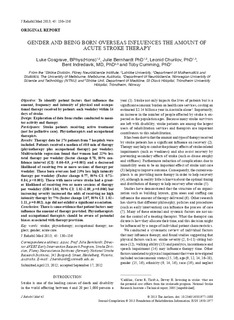| dc.contributor.author | Cosgrave, Luke | |
| dc.contributor.author | Bernhardt, Julie | |
| dc.contributor.author | Churilov, Leonid | |
| dc.contributor.author | Indredavik, Bent | |
| dc.contributor.author | Cumming, Tony | |
| dc.date.accessioned | 2019-10-14T08:06:43Z | |
| dc.date.available | 2019-10-14T08:06:43Z | |
| dc.date.created | 2013-01-20T12:48:34Z | |
| dc.date.issued | 2013 | |
| dc.identifier.citation | Journal of Rehabilitation Medicine. 2013, 45 (2), 130-136. | nb_NO |
| dc.identifier.issn | 1650-1977 | |
| dc.identifier.uri | http://hdl.handle.net/11250/2621857 | |
| dc.description.abstract | OBJECTIVE:
To identify patient factors that influence the amount, frequency and intensity of physical and occupational therapy received by patients each weekday within 14 days of stroke.
DESIGN:
Exploration of data from studies conducted to monitor activity and therapy.
PARTICIPANTS:
Stroke patients receiving active treatment (not for palliative care). Physiotherapists and occupational therapists.
RESULTS:
Therapy data for 274 patients from 7 hospitals were included. Patients received a median of 40.0 min of therapy (physiotherapy plus occupational therapy) per weekday. Multivariable regression found that women had 22% less total therapy per weekday (factor change 0.78, 95% confidence interval (CI): 0.66-0.9, p = 0.001) and a decreased likelihood of receiving two or more sessions of therapy per weekday. Those born overseas had 23% less high intensity therapy per weekday (Factor change 0.77, 95% CI: 0.71-0.84, p < 0.001). Those with more severe stroke had a greater likelihood of receiving two or more sessions of therapy per weekday (OR = 1.05, 95% CI: 1.02-1.09, p = 0.006) but increasing severity increased the odds of receiving no high intensity therapy by 7% (factor change 1.07, 95% CI: 1.02-1.11, p = 0.002). Age did not exhibit a significant association.
CONCLUSION:
There is some evidence that patient factors may influence the amount of therapy provided. Physiotherapists and occupational therapists should be aware of potential biases associated with therapy provision. | nb_NO |
| dc.language.iso | eng | nb_NO |
| dc.publisher | Foundation for Rehabilitation Information | nb_NO |
| dc.title | Gender and being born overseas influences the amount of stroke therapy | nb_NO |
| dc.type | Journal article | nb_NO |
| dc.type | Peer reviewed | nb_NO |
| dc.description.version | publishedVersion | nb_NO |
| dc.source.pagenumber | 130-136 | nb_NO |
| dc.source.volume | 45 | nb_NO |
| dc.source.journal | Journal of Rehabilitation Medicine | nb_NO |
| dc.source.issue | 2 | nb_NO |
| dc.identifier.doi | 10.2340/16501977-1088 | |
| dc.identifier.cristin | 993235 | |
| dc.description.localcode | © 2013 The authors. This is an Open Access article | nb_NO |
| cristin.unitcode | 194,65,30,0 | |
| cristin.unitcode | 1920,15,0,0 | |
| cristin.unitname | Institutt for nevromedisin og bevegelsesvitenskap | |
| cristin.unitname | Medisinsk klinikk | |
| cristin.ispublished | true | |
| cristin.fulltext | original | |
| cristin.qualitycode | 1 | |
